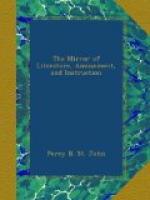[5] Hist. of Whalley.
In Strutt’s view of Manners, we have an
inventory
of furniture in the house of Mr. Richard Fermor,
ancestor
of the Earl of Pomfret, at Easton in
Northamptonshire,
and another in that of Sir Adrian
Foskewe.
Both these houses appear to have been of the
dimensions
and arrangement mentioned. And even in houses
of
a more ample extent, the bi-section of the ground-plot
by
an entrance-passage, was, I believe, universal, and
is
a
proof of antiquity. Haddon Hall and Penshurst
still
display
this ancient arrangement, which has been altered
in
some old houses. About the reign of James I.,
or,
perhaps,
a little sooner, architects began to perceive the
additional
grandeur of entering the great hall at once.
This
apartment subsequently gave its name to the whole
house.—See
an interesting paper on Old English Halls,
Mirror,
vol. xviii. p. 92-108.
[6] Hist. Middle Ages,
vol. iii., p. 423.—The most remarkable
fragment
of early building which I have any where found
mentioned
is at a house in Berkshire, called Appleton,
where
there exists a sort of prodigy, an entrance-passage
with
circular arches in the Saxon style, which must
probably
be as old as the reign of Henry ii. No other
private
house in England can, I presume, boast of such a
monument
of antiquity.
It need scarcely be remarked, in conclusion, that the Hall at Norton Lees, as it appears to the reader, conveys but an imperfect idea of the ancient structure. The walls of the lower story entirely of stone, and the upper, stone and plaster intersected by wood, are original, as is probably the enriched gable, with the pinnacled ornament at its apex; beneath was originally a small bay window, which has been stopped up: the other gable, it is reasonable to conclude, once possessed similar enrichments. The chimneys are modern, since they are neither pyramidal in their terminations, as was the fashion of the 14th and 15th centuries, nor have they the long polygonal shafts of the Elizabethan and subsequent periods, which has caused chimneys to be characteristically termed “the wind-pipes of hospitality.” The “Hall” would likewise appear to be divided into two tenements, which but ill assorts with its original appropriation; though we are not to consider these deviations as affecting the architectural character or identity.




